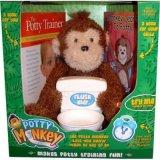A lot of attention has been given to the potty training in a day method. It is appealing to many parents since it appears to be easy and not drawn out. Supporters of this method contend that if a child is ready to be trained, it is less confusing if you spend an entire day on the process. The method that is usually described is very specific. The training is supposed to take place in a room with easily cleaned floors, usually the kitchen. Drinks, snacks, and candies are provided. This approach avoids inconsistent instruction by the parents since they are not supposed to be disrupted by other daily activities. Only one parent should do the instruction. The child is usually naked or lightly dressed with loose clothing so quick placement on the potty is possible. Spending considerable time on the potty is required, and the child may need to be entertained and coached in order to stay there.
The instruction is all inclusive. The child is taught how to remove the clothes, use the potty and empty the potty, flush and replace the clothing. Staying on or near the potty will show the child he can go in the potty and be rewarded. As long as the parents are encouraging and diligent, the child may not view it as a forceful process. However, the classical teaching of this method included scolding and gentle discipline. Rewards are provided usually in the form of treats or stickers. The 5-10 hour method can be very effective if parents choose a time when the child wants to please their parents and if the child is truly ready to potty train.
Several child specialists have spoken openly against this method. It is sometimes viewed as an intensive program that gives parents unrealistic expectations. It is also perceived as a process that does not allow children any input to the process. Those against this approach contend that if the child is not “ready” then this intensive instruction will be detrimental to normal parent-child relationships. Opponents say this technique teaches kids to only go on command and not learn the correct process for themselves. Furthermore, they believe these children may actually take longer to train because they become resistant to forceful instruction.
On the other hand, this was a very common technique that was used when cloth diapers were commonplace. Parents were loving but motivated. Success was common and some flexibility was usually allowed. Children still loved their parents at the conclusion and many were well trained. The approach instilled good practices and responsible actions in regards to toilet training. All of the aspects of toilet training were usually incorporated with this approach and these included:
- Undressing
- Sitting on the potty
- Emptying the potty (including flushing) and avoiding messes
- Hand washing and good hygiene
- Dressing
Parents who love their child and do not want any ill will still use this technique today. Long-term studies have not been produced that show any adverse problems when using this approach in a loving and caring environment.



i have i 4 year old son that will not use the potty if it is for a bowel movement he just hides away in the corner. is there anythingmu can do. ive tryed everyy method and read several books on this process. please help
I wonder whether this MD is in favor of this approach or not. where does he stand (or sit) on this issue? 1
I am appalled that you would promote a. any method that uses a 5-10 hour method of focus for a young child and b. the use of “treats” as rewards. Any early childhood educator knows that these 2 things are not good for young children. You even have to keep them in one area and you say the “historical teaching of the method included “scolding and gentle discipline”. Unreal! I am thoroughly disgusted. Goes against everything we teach families to do in early care and education. Have you read about “best practices”? Obviously not!
It really just sounds like the Dr. here is presenting this idea, explaining it to people who might have been wondering about the fastest method possible, as I’m sure many parents are and do. Who wouldn’t want something like the transition of potty training your child to happen as smoothly and quickly as possible? I don’t think he necessarily says this is his “go-to” method of training – if anything I’d say he’s pretty detached from it. I don’t think it’s very fair to come down on him so hard. I don’t really see this as a great method, seems a little too old-school. Parents AND children have evolved and there are much better ways to deal and accommodate their individual needs rather than to staple an approach to the situation and test out theories and methods. My girlfriend and I just bought our newly-turned two-year-old a potty so that he’d be used to having it around, slowly learning about it, as well as continuing to be involved when we’re going to the bathroom. He’s starting to show signs of understanding, and we’re slowly embracing that as he grows closer towards truly understanding the process. Our plan was to build up to that point and do the weekend of immediately eliminating diapers, allowing him to learn the discomfort of soiling his clothes, and he’ll probably get it pretty quick when he’s ready to be there. Obviously the most important factors are LOTS of love and encouragement, and teamwork. You have to be as involved as you want them to be : )